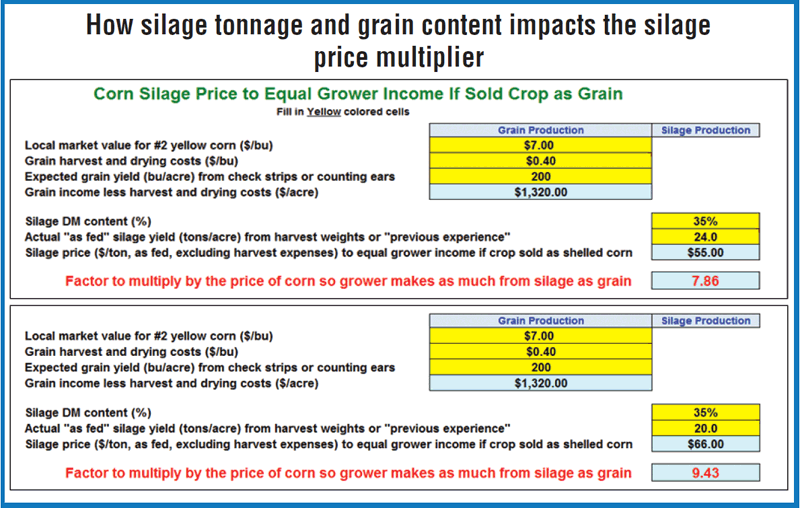Pricing Corn Silage Still Poses a Challenge
By Bill Mahanna, Global Nutritional Sciences Manager, Seed, Corteva Agriscience
By Bill Mahanna, Global Nutritional Sciences Manager, Seed, Corteva Agriscience
In the past month, I have walked corn fields from Colorado to Vermont and many states in between. To say this was a challenging corn growing season would be an understatement. Many growers experienced a wet spring and delayed planting, followed by pollination and ear “nosing-back” issues caused by some of the highest July and August temperatures on record. To make matters worse, the Northeast was hit by severe flooding courtesy of Hurricane Irene. These environmental stressors have resulted in a corn crop that is exhibiting significant variation in terms of plant height and ear development.
The variation in tonnage and starch content is causing many dairies to struggle with how to price corn silage this year. After talking with dairy producers and their silage growers, both groups seem to prefer simplicity. There are dozens of approaches to pricing silage, ranging from paying growers a price similar to what they would have received if harvesting the corn for grain (less harvest and drying costs) to more complicated methods of analyzing the crop for starch content and/or reimbursing growers for the fertilizer value of the stover removed from the field (assuming that manure is not being traded).
The current method for calculating the relationship between corn grain yield and silage yield by using a multiplier factor (e.g., seven) times the price of corn first appeared in a 1972 University of Wisconsin dairy science extension publication (Jorgensen and Crowley, 1972).
Inherent in this approach is the assumption that every ton of moisture-adjusted silage contains 7 bu. of grain corn. Not only is this incorrect when considering highly variable fields, but since the early 1970s, much improvement has been made in pest/disease resistance, allowing for healthier plants that can withstand the stress of much denser plant populations.
As a result, older multiplier factors need to be recalculated for today’s corn plants, which are capable of producing higher proportions of grain for which corn growers expect to be paid.
To illustrate the genetic increase in grain yields along with possible variability, one only has to look at a 2004-05 study conducted at the University of Wisconsin (Lauer, 2006). Six corn hybrids were grown at six locations.
Hybrid types included brown midrib, leafy, transgenic and conventional hybrids. Each hybrid was replicated three times and grown in eight-row plots, with four rows harvested as silage and four rows harvested later as grain.
When looking across locations and years, the multiplier of seven was fairly predictive because the average grain-equivalent yield was 7.5 bu. per ton (bushels of grain at 15.5% moisture per ton of corn silage adjusted to 65% moisture). However, what perceptive corn growers will point out is the range observed across environments (2.3 bu. of grain per ton) and among hybrids (6 bu. of grain per ton).
More sophisticated growers are not satisfied with taking an “average” multiplier for their silage, similar to how dairy producers would object to the processor offering the “average” price for milk without any compensation for extra protein or fat.
This led the Wisconsin researchers to suggest that, given the wide range in grain equivalents among hybrids and within environments, dairy producers and grain farmers should devise alternative methods for calculating the amount of grain in corn silage.
That was a difficult goal back in 2005, but with the availability today of inexpensive and accurate near-infrared spectrometry starch analyses, this could be accomplished by establishing a protocol to measure starch in representative silage samples and back-calculating the dry grain yield.
Another approach includes leaving check strips to combine later (not a very convenient solution), or a slightly less accurate method is to estimate grain yield in the field by counting ears and kernels (Lauer, 2002).
To illustrate my point, the Figure below shows a screen shot from one of my spreadsheets that’s designed to price corn silage such that the grower will make the same income from silage as from selling the crop for grain (minus harvest and drying costs). The multiplier would be 7.8 if grain yields averaged 200 bu. per acre and silage tonnage was somewhat normal (24 tons per acre), but the multiplier would be 9.4 for a 200 bu. average yield if overall silage tonnage was reduced (20 tons per acre) due to growing conditions (late planting, dry summer, etc.) that caused shorter-statured plants.

It has been my personal experience that when alternative approaches to the standard multiplier approach to pricing corn silage are discussed on the farm, eyes roll, and the holy grail of having a “simple” method that all growers can understand is presented as the obstacle to making a change.
Change will certainly require an educational effort, especially considering that hay sellers and buyers often still do not fully understand that both samples need to go to one agreed-upon laboratory. However, I do think that more sophisticated approaches would more fairly benefit both dairy producers and silage growers.
This article was originally published in the October 2011 issue of Feedstuffs. Reproduced with permission.